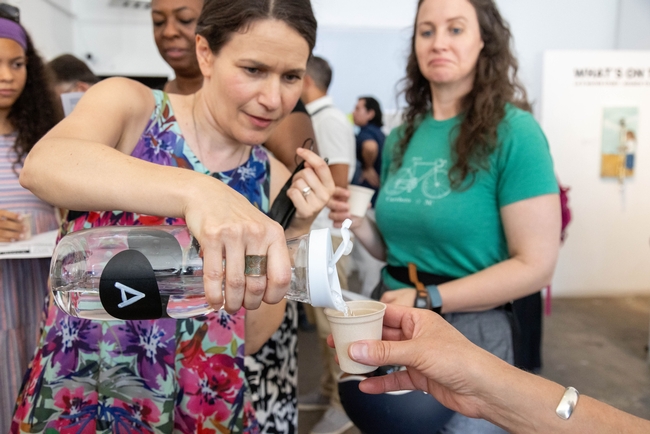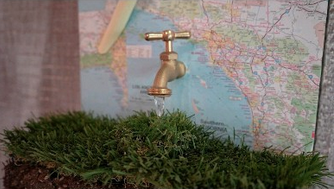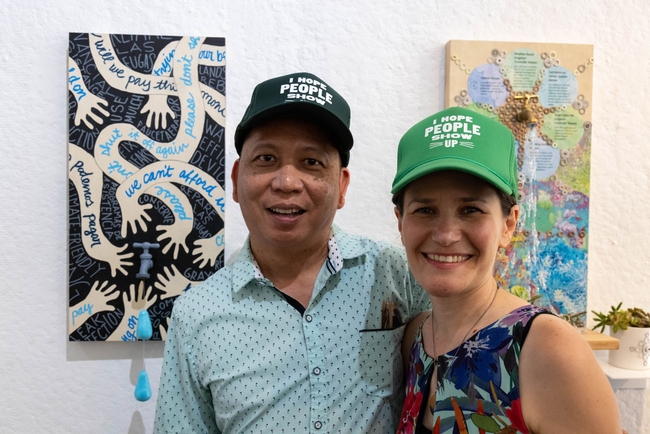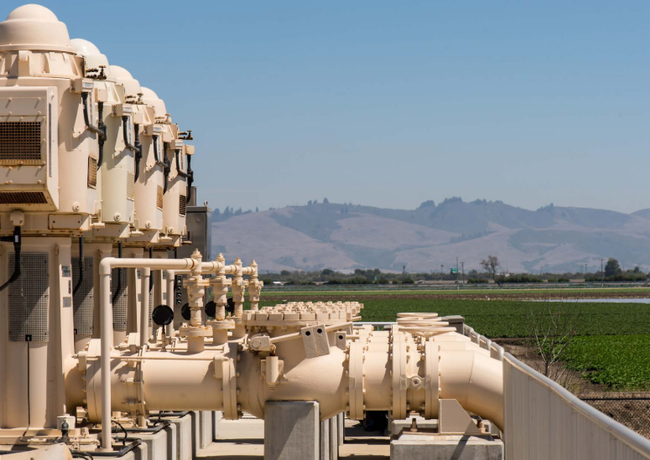Posts Tagged: Water
Water discussion on Sept. 29 flows from LA art exhibit
Communities in Los Angeles and around California face a variety of water challenges ranging from access to clean, affordable water to water supplies threatened by a changing climate.
The public is invited to a free event featuring a panel discussion of the past, present and future of Los Angeles water. The water discussion will be part of the closing reception for the art exhibit “What's On Tap: LA's Water Story…Source to Spigot” at El Tranquilo Gallery in Los Angeles on Sunday, Sept. 29.
“I hope that people come away understanding that our relationship to and stewardship of water in LA is not only a critical part of our past history, but essential to determining our region's future as well,” said Edith B. de Guzman, UC Cooperative Extension specialist for water equity and adaptation policy with UC Agriculture and Natural Resources and UCLA Luskin Center for Innovation.
The panel will be moderated by UCLA Public Policy Professor Megan Mullin. Panelists will include de Guzman; Amanda Begley, watershed senior program manager for TreePeople; Conner Everts, facilitator for the Environmental Water Caucus, executive director of the Southern California Watershed Alliance, and co-chair of the Desal Response Group; and Mark Gold, director of water scarcity solutions for the Natural Resources Defense Council.
The discussion will be followed by a blind water tasting. Participants will be able to taste how the flavors of three brands of bottled water compare with each other and Los Angeles Department of Water and Power tap water.
“Thus far, many people have chosen LADWP tap as their favorite compared to the bottled brands,” de Guzman said. “So another hope I have is that people will come away with greater appreciation and trust of tap water.”
The art exhibit, curated by Edith and Jolly de Guzman, highlights five distinct water themes that affect Southern California communities – local water, imported water, tap trust, human right to water and affordability.
The Zanja Madre, a Spanish-era aqueduct that moved water from the Los Angeles River to the pueblo of Los Angeles between 1781 and 1904, once ran past the gallery location.
The “What's On Tap: LA's Water Story…Source to Spigot” exhibit will be open from 11 a.m.-3 p.m. Friday through Sunday, Sept. 27-29, with the closing reception 3-6 p.m. on Sunday, at El Tranquilo Gallery, W-19 Olvera Street, Los Angeles 90012. The panel discussion will begin at 4 p.m. The reception will include live music by Shoshana Ben-Horin.
Hands-on learning, training make irrigation best practices accessible
UCCE advisors provide free training to nursery and greenhouse staff
Working as an irrigator seems straightforward at first: if you're not watering plants by hand, you're building and managing systems that can do the watering. What could be complex about a job like this?
University of California Cooperative Extension advisors Bruno Pitton and Gerardo “Gerry” Spinelli can tell you – or better yet, show you.
Pitton and Spinelli, members of the UC Nursery and Floriculture Alliance, offer a one-day technical training in irrigation best-management practices for irrigators working with containerized nursery plants. The comprehensive curriculum – developed with input from two focus groups of California nursery and greenhouse managers – aims to improve irrigation efficiency, reduce water consumption and improve plant health.
Thanks to funding from the California Department of Food and Agriculture, nursery and greenhouse managers in California can request this training for free and advisors like Pitton and Spinelli will travel to conduct the training on-site.
The complexities of irrigation incorporate concepts like evapotranspiration, salinity, irrigation uniformity, capillarity, pressure and flow rate. Spinelli, UCCE production horticulture advisor for San Diego County, said that irrigators have a critical role in the industry because of all the things they must consider to do their job well.
“Our goal is to support irrigators and help them become more confident decision-makers and experts in the field,” said Pitton, UCCE environmental horticulture advisor for Placer and Nevada counties.
Interactive sessions reveal nuances of irrigation
The training consists of a presentation on fundamental concepts for managing irrigation in container plant production and hands-on demonstrations. “In the nursery industry, where precise irrigation is crucial for the health and productivity of our crops, having access to expert knowledge is invaluable,” said Mauricio de Almeida, general manager of Burchell Nursery in Fresno County. “The training's practical demonstrations and real-world examples made the concepts easy to grasp, allowing our team to implement the strategies immediately.”
For one of the demonstrations, the advisors used sponges to model soil saturation when water is applied. Ana, an irrigator at Burchell Nursery, appreciated the step-by-step explanations, which helped her better understand how water pressure differs in drip irrigation, sprinklers and watering by hand. Doing this out in the field, as an example of how irrigation audits occur, was extremely helpful for attendees.
Francisco “Frank” Anguiano, production manager of Boething Treeland Farms in Ventura County, observed his team of irrigators as they learned how to measure distribution uniformity with water collected from sprinklers. “This training isn't just about irrigation and plant management. It's also about savings, both water and costs. Who doesn't want to save money and use less water?” Anguiano said.
Reducing the barriers to learning
Many of the irrigators attending these trainings gained their skills and knowledge from life experience rather than a college education, explained Peter van Horenbeeck, vice president of Boething Treeland Farms. “It's important that my irrigators learn from external experts, but it's more important that they can relate to them. And that's what Gerry was able to do,” van Horenbeeck added.
Regarding content and delivery, and referencing what he learned from the focus groups, Pitton wanted the trainings to be easy to understand and engaging. For example, scientists use the term “matric potential” to describe how soil particles hold water against gravity, which is the same as capillary rise. “We demonstrate this concept with a paper towel held vertically and dipped into a beaker of dyed water that it absorbs,” said Pitton.
Many of the irrigators in attendance agreed that hands-on activities and visual aids were instrumental to their learning. Charli, another irrigator at Burchell Nursery, shared that the in-field examples and hosting the training in Spanish kept them engaged.To address language barriers, Spinelli has been conducting trainings in Spanish – a common request from many nurseries with eager participants.
Maintaining state regulations and partnerships
Although the technical aspects of irrigation management are key elements of the training, regulatory compliance is also addressed. Recognizing the finite availability of water and the environmental impact of pollution, the advisors highlight irrigation and fertilizer management and runoff prevention as critical components of compliance.
Under Ag Order 4.0 administered by California's Water Resources Control Board, growers must comply with stricter policies regulating nitrogen use. As irrigators learn from the training, better control of irrigation can certainly make a difference.
Deanna van Klaveren, chief operating officer and co-owner of Generation Growers in Stanislaus County, said the most valuable aspect of the training was learning on-site and completing an audit on her own systems. “It is so much more impactful to have trainings like this on-site where our staff can learn and then go out into the nursery and actually put it into practice while the presenters/experts are there,” van Klaveren said.
Pitton and Spinelli described the partnership between UC Cooperative Extension and CDFA as “symbiotic” given the technical and educational capacity of UCCE advisors who conduct research and extension.
“It's a great example of how the two institutions can collaborate successfully. Californians are the ones who win because they get a service for free,” added Spinelli. “And it's rewarding for us to see so much interest in what we, as advisors, do.”
If you are a nursery or greenhouse operator and would like to request the Irrigation Best Management Practices training, please contact the UCCE advisor assigned to the region that corresponds with your nursery location below.
Northern California
- Jessie Godfrey, UCCE environmental horticulture and water resources management advisor, jmgodfrey@ucanr.edu
Central Coast (Santa Cruz County to Ventura County)
- Emma Volk, UCCE production horticulture advisor, evolk@ucanr.edu
San Joaquin Valley
- Chris Shogren, UCCE environmental horticulture advisor, cjshogren@ucanr.edu
Southern California
- Grant Johnson, UCCE urban agriculture technology advisor, gejohnson@ucanr.edu
Spanish Trainings Only
- Gerry Spinelli, UCCE production horticulture advisor, gspinelli@ucanr.edu
UCCE offers water measurement training Sept. 13 in Salinas
California water-rights holders are required by state law to measure and report the water they divert from surface streams. For people who wish to take the water measurements themselves, the University of California Cooperative Extension is offering in-person training to receive certification on Sept. 13 in Salinas.
At the workshop, participants can expect to
- clarify reporting requirements for ranches.
- understand what meters are appropriate for different situations.
- learn how to determine measurement equipment accuracy.
- develop an understanding of measurement weirs.
- learn how to calculate and report volume from flow data.
The training is scheduled for 1 to 5 p.m. on Sept. 13 in the UC Cooperative Extension Conference Room at 1432 Abbott Street in Salinas.
“We are limiting the number participants for the water measurement training to 30 people per session,” said Larry Forero, emeritus UC Cooperative Extension livestock and natural resources advisor. “If you need this training, please register soon.”
Pre-registration is required and the fee is $30. To register, visit https://surveys.ucanr.edu/survey.cfm?surveynumber=43495. If you have questions, email Forero at lcforero@ucanr.edu or Sara Jaimes at sbjaimes@ucanr.edu, or call (530) 224-4900.
Report: Wastewater recycling essential to resilient water future for LA region
Wastewater recycling in Los Angeles is the focus of a new report released by the UCLA Luskin Center for Innovation and the UC Agriculture and Natural Resources. The report, Making the Most of Landmark Recycled Water Investments in Los Angeles: Technical Advisory Recommendations for the Region, was commissioned by Los Angeles Waterkeeper. The goal of the report is to support ongoing efforts to improve local water security and rely less on expensive, energy-intensive and increasingly unreliable water imports from faraway places, like the Sacramento-San Joaquin Delta and the Colorado River.
Experts involved in developing the report agree that expanding the use of recycled wastewater has emerged as a key, scalable water supply strategy that can offer certainty and reliability in the region in light of our new climate reality.
“Both the Metropolitan Water District of Southern California and the City of LA's Department of Water and Power have made significant investments in wastewater recycling, and they plan to do more,” said Bruce Reznik, executive director of LA Waterkeeper. “But there are a lot of moving parts and some critical decisions to be made in the short term if we're going to make significant progress toward reliable local water supplies.”
“The purpose of this report is to help decisionmakers see the full picture so they can prioritize and develop informed strategies for expanding and integrating the disparate wastewater recycling projects into a more cohesive wastewater system – all while taking community voices and environmental impacts into account,” he added.
Local leaders recognize the region must further invest in equitable, climate-smart, affordable local water strategies. LA County's Water Plan, released in late 2023, calls for 80% of water to come from local sources by 2045 (compared with approximately 40% currently). Four major centralized wastewater recycling projects, including two that are landmark in size and scope, have either broken ground or are in the active planning stages throughout Los Angeles County. Collectively, this regional effort may represent the most important water supply investment in the American West in the last half century.
“In many ways, our region has taken great strides toward embracing wastewater recycling,” said report co-author Edith B. de Guzman, UC Cooperative Extension water equity and adaptation policy specialist. “But we need a clearer pathway for how these projects can be built and possibly integrated into a more cohesive system. This report provides a blueprint for water agencies on the project design, community engagement and governance steps that must be made to ensure progress toward rapidly increasing our local water independence.”
Upwards of $20 billion in investment in wastewater recycling projects is planned for the coming years. But as local water and wastewater agencies make these investments, it's essential that they design systems to both maximize benefits and minimize impacts that could be damaging to people and the environment, all while ensuring water remains affordable. Just as importantly, the report flagged the need to effectively engage the public in key decisions to foster public trust in these emerging water technologies and facilitate coordination between agencies to create a resilient regional water supply system.
Specific action items identified in the report are organized under eight principal recommendations:
- Take actionable steps on current key decision points pertaining to major recycling facilities. The report encourages agencies to make several decisions that will impact the design of the overall wastewater recycling systems imminently. These include resolving differences between the City of LA's Hyperion 2035 and Operation NEXT efforts, deciding whether to upgrade existing wastewater recycling infrastructure like the Edward C. Little Water Recycling Facility, and making key pipeline and routing decisions.
- Conduct a more nuanced regional analysis of system facilities, with an emphasis on evaluating distributed alternatives. While some assessment of a more distributed system has been undertaken, additional analysis is still needed on the issues of energy demand, the cost of distributing water under different alternatives, and impacts on aquatic and marine ecosystems.
- Identify and establish a structure for collaborative governance that enables agencies to work together to realize a regional advanced wastewater recycling network.
- Adopt a coordinated monitoring plan to ensure water quality is safeguarded for public and ecological health.
- Balance the adoption of Indirect Potable Reuse (IPR) and Direct Potable Reuse (DPR) with a near-term focus on IPR to the extent feasible and using DPR to fill in service gaps.
- Perform robust regional forecast and impact analyses to improve future-proofing of facility and network designs, maximize benefits, minimize harm, and avoid stranded assets.
- Design and execute a collaborative communication and community engagement strategy that offers a clear narrative, emphasizes the benefits of a secure water supply, meets the needs of water customers, and is delivered by trusted messengers.
- Coordinate across agencies on strategies to attract project financing while taking household affordability into account.
“This report is by no means the final word,” said co-author Gregory Pierce, research and co-executive director at UCLA Luskin Center for Innovation. “The point of this study is to provide guidance and spur discussion, and we hope and expect to see ongoing research and coordination on all of these issues.”
The report was informed by input from a Technical Advisory Committee of 20 people from fields including academia and think tanks, conservation advocacy, labor, the private sector, and current and former water district leaders not affiliated with the projects that are the focus of the report. This effort also benefited from the feedback and insight of more than 20 public agency representatives, including many from the City of Los Angeles (including Los Angeles Department of Water and Power and LA Sanitation and Environment), Metropolitan Water District of Southern California, Los Angeles County Sanitation Districts, Las Virgenes Municipal Water District, and West Basin Municipal Water District.
The full report is available at https://innovation.luskin.ucla.edu/wp-content/uploads/2024/06/Making-the-Most-of-Landmark-Recycled-Water-Investments-in-LA.pdf.
The Water Girls
If you're struggling with triple-digit temperatures, think about the honey bees. They need to collect water for their colony to cool the hive so...
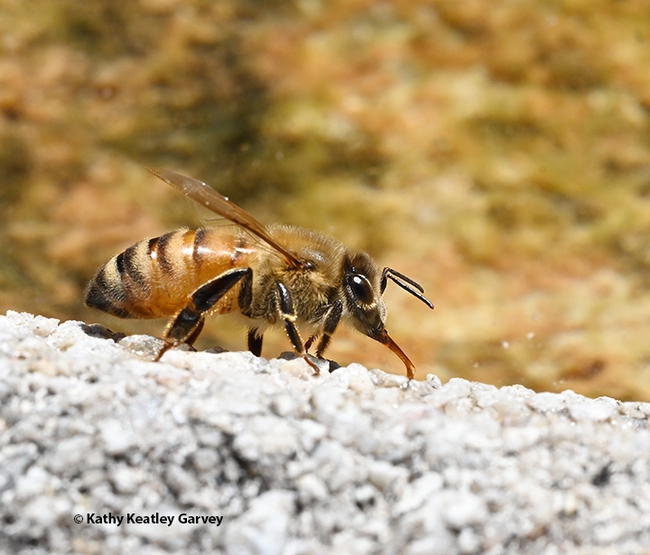
A honey bee, its proboscis extended, collects water from the edges of a birdbath. (Photo by Kathy Keatley Garvey)
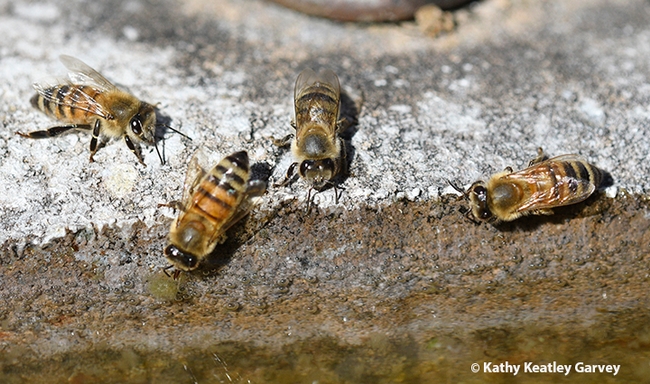
For worker bees: Two's company, three's a crowd, and four is a work party. Bees collecting water from a birdbath. (Photo by Kathy Keatley Garvey)
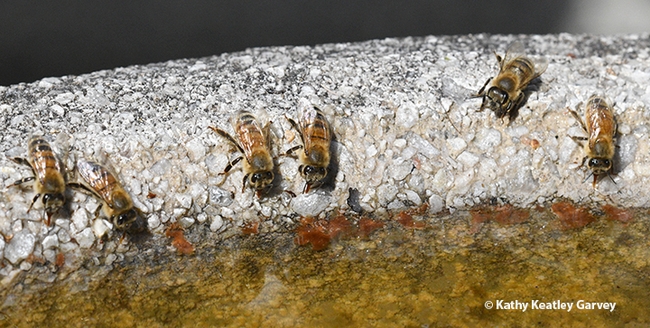
'The Water Girls'--six of them--collecting water at a Vacaville birdbath. Note the absence of birds. (Photo by Kathy Keatley Garvey)
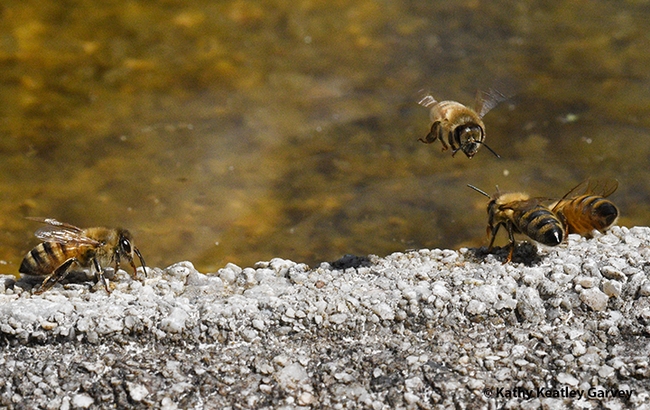
A honey bee heading back to her colony after collecting water to cool down the hive. (Photo by Kathy Keatley Garvey)


